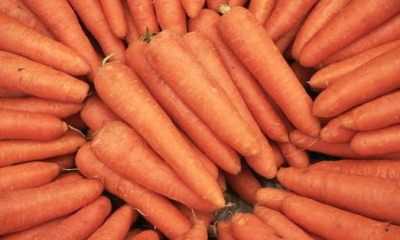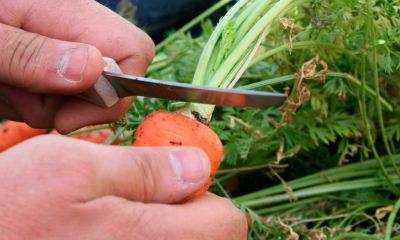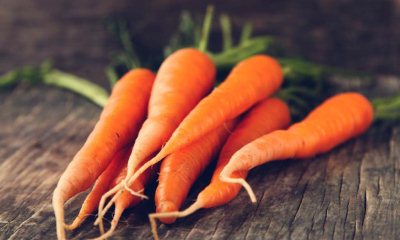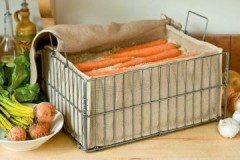A few secrets on how to prepare carrots for storage for the winter
 Organization storing carrots - a troublesome business. There are a number of conditions you need to adhere to to keep your roots fresh.
Organization storing carrots - a troublesome business. There are a number of conditions you need to adhere to to keep your roots fresh.
Among them is the preparation of the storage area and containers, as well as the processing of the carrots themselves.
In this article, we will tell you in detail how to prepare carrots for storage for the winter, including how best to choose a place and container for a root crop.
Content
Root preparation
The long shelf life of vegetables is determined by several factors:
- growing region;
- variety;
- weather conditions;
- the state of root crops.
For regions with a warm climate, late varieties are grown for storage. But for places with unstable summer weather, this option is not suitable - the carrots do not have time to ripen to the end. It is optimal to harvest mid-season root crops.
Why cropping?
After harvesting, the tops are cut from the carrots. This is necessary so that the green shoots do not draw on moisture during the drying process.
 Trimming rules:
Trimming rules:
- Cutting the leaves above the head.
- Cutting off the base - an area with a height of 0.5 to 3.0 cm is cut off if there is damage.
- Allow the slices to dry.
Pruning should be done with a sharp knife to keep the cut straight. The purpose of pruning is to prevent the germination of harvested root crops.
At the same time, nutrients will not be wasted to maintain the leaves that are no longer needed, which will make it possible to better organize the storage of vegetables.
What is drying for?
After cutting the tops, the carrots should be well ventilated. For this, sheds are organized, under which the harvested crop is kept for 1-1.5 weeks. The optimum temperature is from + 10 ° C to + 14 ° C.
Such aging is necessary in order to ensure the following conditions:
- identify spoiled fruits;
- dry the cut site.
To wash or not to wash?
There is no definite answer to the question of whether it is necessary to wash carrots before harvesting for the winter. Regardless of the choice of processing method (with or without washing), vegetables should be thoroughly dried.
There is no direct relationship between washing a vegetable and its shelf life.
Additional processing
 Pre-spraying with a solution of onions or needles will help extend the storage period of vegetables.
Pre-spraying with a solution of onions or needles will help extend the storage period of vegetables.
To prepare it you need:
- water (2 l.);
- 200 grams of pine needles or husks.
Preparing a solution is easy:
- The dry component is poured with water.
- Insist 5 days.
- Strain through cheesecloth.
The resulting solution can be used in two ways:
- By spraying root crops.
- Soak briefly for 10 minutes and then dry.
Choice of place and container
There are several ways to preserve root vegetables. for winter. Among them:
- falling asleep with wet sand (this is the most common method);
- the use of clay;
- packing in polyethylene;
- tamping in containers;
- sprinkling with husks, etc.
Cellar or basement requirements
 In the place of storage of carrots, the air temperature should be maintained at a level from + 1 ° C to + 4 ° C. To prevent rotting, it is necessary to provide medium ventilation with an air humidity of at least 90%.
In the place of storage of carrots, the air temperature should be maintained at a level from + 1 ° C to + 4 ° C. To prevent rotting, it is necessary to provide medium ventilation with an air humidity of at least 90%.
This is necessary so that natural moisture does not evaporate from the surface of the root crops, and the carrots do not begin to wither.
All of the above conditions must be met by a basement or cellar intended for wintering crops... In such a room, a constant temperature and humidity is maintained, as well as protection from sunlight and other external factors. Among them is protection against flooding by groundwater.
What to store?
Most storage methods will require boxes. They should have a bottom, through which sand will not spill and reliable sides. The number of boxes is determined by the volume of the crop.
If a method is chosen to store the root crop in plastic bags, then the blanks will not be needed too large, designed for 3-5 kg of carrots each. When open, they allow you to maintain an optimal humidity level of about 97%.
Prohibitions
In the process of harvesting carrots some prohibitions must be taken into account:
- Damaged root crops are not harvested for the winter. They should be recycled or consumed first.
- Ventilation should not be too great, otherwise vegetables will sprout.
- Do not store the crop in a dry place - vegetables will deteriorate due to moisture evaporation.
- Apples and carrots should not be stored in the same room, as these fruits release ethylene, which can spoil vegetables.
- In one box, storing carrots should be in only one chosen way. It's not worth combining everything at once.
7 recommendations
Root preservation can be simplified by putting the following tips into practice:
 Harvesting is desirable in dry weather.
Harvesting is desirable in dry weather.- If the carrots are not harvested in the first light frosts, it will not harm the vegetable.
- It is advisable to dig out with a pitchfork, holding the tops with your hand. This method is less traumatic for root crops compared to working with a shovel.
- Damage to the surface of carrots resulting from improper harvesting significantly reduces shelf life.
- Before storing, you should try to clean off large lumps of earth.
- In addition to sorting by the quality of root crops, it is advisable to sort the crop by the size of carrots so that their consumption starts with small ones.
- Before placing the carrots in the basement for storage, the remnants of the past harvest should be removed from it, and the room and shelves should be disinfected, for example, with slaked lime.
The shortest storage method is cellophane in the refrigerator (from one to two months).
Related Videos
Important points for preparing carrots for storage are presented in the video:
Conclusion
Choosing a way to store carrots, you should take a responsible attitude to the creation of the necessary conditions and to the processing of the vegetables themselves, since if the technological process is violated, the entire crop may be lost. Even one rotten carrot can spoil a large volume of a quality product..



